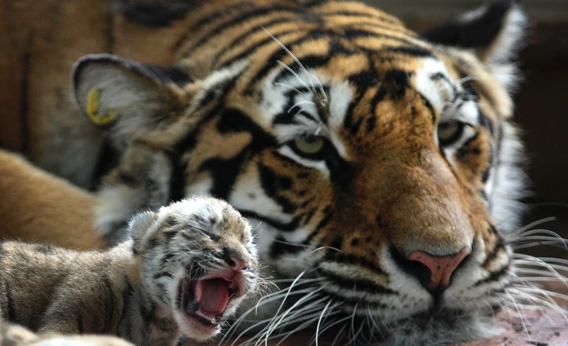Sunday is Mother’s Day, when we celebrate the women who raised us, cradled us close, and supported us tenderly even when we failed spectacularly. That is, unless you were raised by a tiger mother, that demanding type of mom celebrated in Amy Chua’s 2011 best-seller. Are actual tigers as tough on their kids as Chua was?
Not at first. A tiger mother is fiercely protective and slightly coddling for the first couple of months, when her cubs are defenseless and nearly blind. She conceals them in a cave or dense vegetation and moves them if she suspects they’re being surveilled. She leaves them only to hunt. When the cubs reach six months, the training begins, although a tiger mother isn’t the taskmaster Chua seems to be. Whereas the Yale Law professor admits to berating her children, denying them bathroom access, and tearing up their sheet music when they underperform, the tiger brings her cubs along slowly. In the first hunting lesson, she typically selects a smaller form of prey—a chital, for example, rather than big game like gaur or water buffalo. Cubs instinctively know how to stalk prey, but they have to observe their mothers to learn the finer points of the art, such as how to use vegetation as a screen. The tiger stalks, slinks, and eventually pounces, but she only wounds her target. Once the prey is essentially defenseless, she invites the cubs to finish it off. As the lessons progress, the prey gets larger and the mother provides less help, until the cubs are about 2 years old.
At this point, the offspring are an enormous burden. They’re nearly as large as their mother, sometimes larger. A tiger’s territory isn’t extensive enough to support several adult-size individuals, so it’s time for the cubs to get out. Tigers don’t tearfully send their kids off to college; they have harsher ways of emptying the nest. Some mothers share less and less food until the young realize they can’t survive by freeloading on mom’s kills any longer. Other tigers become true “tiger mothers,” delivering a dose of tough love that even Amy Chua would have difficulty administering. They physically attack their young, swiping at them and battering them. They roar loudly, letting the adolescents know in no uncertain terms that they must leave. The abuse continues until the offspring finally slink off to begin their solitary adult lives.
The stakes for a tiger mother in the wild are vastly higher than for Chua’s tiger mothers. When Chua’s children disappointed her, they faced a scolding and perhaps some other mild inconveniences. In a worst-case scenario, they wouldn’t get into a top college. If a tiger cub fails to learn how to hide, hunt, and defend itself, it dies. Around 35 percent of tiger cubs die before adulthood. Many fall prey to unrelated adult males who kill cubs to make the mother available for breeding again. (The notion of a tiger defending her young to the death is something of a caricature, reflecting human ideals more than reality. When confronted with a much stronger male, many tiger mothers abandon the litter to its fate.)
There’s one area in which human tiger mothers far surpass the skills of their wild namesakes: adaptability. Chua celebrates Asian immigrants for reorienting their parental demands toward the requirements of Ivy League admission. But real tigers are still training their young for the challenges of a pre-human world. The primary threats to tigers are habitat loss and predation by humans. More than 90 percent of the tiger’s natural range has disappeared, and poaching is a multibillion dollar industry.
Got a question about today’s news? Ask the Explainer.
Explainer thanks Andrea Heydlauff of wild cat conservation organization Panthera and Pat Thomas of the Wildlife Conservation Society-Bronx Zoo.
